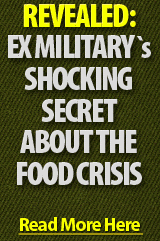Madison Ruppert, Contributor
Activist Post
In a damning new 115 page self-learning course from the U.S. Army Military Police School at Fort McClellan originally issued in April 2006, we learn that the military has a detailed and brutal plan in store in times of mass civil unrest in the United States.
This likely comes as no surprise to readers who are familiar with my work on the military’s Internment/Resettlement Operations manual (video is also embedded below), my coverage of the designation of civilian internee in military literature, my coverage of KBR’s so-called “National Quick Response Teams,” and the FEMA “National Responder Support Camps.”
However, this document (available HERE), originally published on July 6 by Public Intelligence, reveals some quite disturbing and clearly institutionalized practices which can and will be used in a time of civil unrest.
It is important to note that this document specifically states:
The same operational procedures that apply to the operation of installation confinement facilities [see above video] and treatment of detainees apply to these temporary facilities except that those policies and procedures establishing training, employment, mail and correspondence, and administrative discipline requirements will not apply.
However, the course cites Field Manual (FM) 3-19.40, originally issued in August of 2001, which appears to be the earlier version of the FM 3-39.40, originally published in February of 2010. Obviously since this edition of the course is dated April 2006, FM 3-39.40 didn’t exist at the time it was written.
At this point it is also noteworthy to point out that the document says:
The Army will not operate facilities for confinement, custody, or detention of civilian personnel apprehended for violation of local or state laws as long as civil confinement facilities, operated by the Department of Justice, state, or local agencies are sufficient to accommodate the number of persons apprehended.
Therefore, it appears to be the case that military detention facilities will not be used unless there are not sufficient facilities operated by the DOJ, state or local law enforcement. At least we can hope to be thrown in a dangerous, filthy, and overcrowded “civil confinement” facility instead of a military internment camp.
If the military does set up detention facilities:
These facilities will be operated only until custody of the persons detained can be transferred to and assumed by civil authorities. They will not be used for the confinement of persons charged or convicted under civil jurisdiction.
 However, this was written long before the National Defense Authorization Act for fiscal year 2012 and the indefinite detention sections included which allow the military to hold Americans without charge or trial indefinitely. These above guidelines have almost certainly been removed having been given this power when Obama signed the NDAA.
However, this was written long before the National Defense Authorization Act for fiscal year 2012 and the indefinite detention sections included which allow the military to hold Americans without charge or trial indefinitely. These above guidelines have almost certainly been removed having been given this power when Obama signed the NDAA.
While a judge indeed stepped up against the indefinite detention sections of the NDAA, I seriously doubt that this decision would be honored in a time when the military is actually rolled out to quell civil unrest.
The course is designed for operations inside the continental United States (CONUS) or outside the continental United States (OCONUS) in cases of civil disturbances when “the President is advised by the highest officials of the state that the situation cannot be controlled with nonfederal resources available.”
The “control force,” as these military police groups are referred to in the course, is mandated “to help restore law and order and to help maintain it until such time as state and local forces can control the situation without federal help.”
In other words, there is no restriction in terms of how long these forces can remain in a given area helping “restore law and order.”
The course clearly states that these soldiers will not just be used “in subduing the disturbance” which is what one might expect. Instead, they are actually going to be carrying out law enforcement activities.
This is incredibly important because while the act of “subduing the disturbance” would, likely, be defensible under Posse Comitatus and the Insurrection Act, it is much harder to defend the military “helping to detain those responsible for [the disturbance].”
Speaking of the fact that, “the control force may have to actively participate, not only in subduing the disturbance, but also in helping to detain those responsible for it,” the course states that, “Control force commanders are authorized and directed to provide such active participation, subject to restraints on the use of force.”
It appears that the law enforcement role of the military will be far from negligible seeing as, “Commanders are authorized to use non-deadly force to control the disturbance, to prevent crimes, and to detain persons who have committed crimes; but the degree of force used must be not greater than that reasonably necessary under the circumstances.”
Of course, the degree of forced which is “reasonably necessary under the circumstances” is usually quite different in the eyes of the police and military compared to how the individuals actually receiving the “non-deadly force” see it.
One of the most disturbing aspects of this course comes when they are dealing with the use of deadly force.
Some of the policies regarding the use of deadly force which the military will observe are: give an order to halt, warning shot will not be fired, when a firearm is discharged it will be fired with the intent of rendering the person(s) at whom it is discharged incapable of continuing that activity or course of behavior prompting the individual to shoot, shot will be fired only with due regard for the safety of innocent bystanders and in the case of holstered weapons, a weapon should not be removed from the holster unless there is a reasonable expectation that use of the weapon may be necessary.
You read that right; there will not be a warning shot. At least they’ll tell you to halt before they make your face look like a watermelon dropped off a third story roof onto cement.
 The course outlines when deadly force is justified and gives the following circumstances, only one of which need be fulfilled. However, they do state, “The use of deadly force is authorized only under conditions of extreme necessity and as a last resort when all lesser means have failed or cannot be reasonably be employed.”
The course outlines when deadly force is justified and gives the following circumstances, only one of which need be fulfilled. However, they do state, “The use of deadly force is authorized only under conditions of extreme necessity and as a last resort when all lesser means have failed or cannot be reasonably be employed.”
The circumstances in which deadly force is justified are:
(a) Self- defense and defense of others. When deadly force reasonably appears to be necessary to protect law enforcement or security personnel who reasonably believe themselves or others to be in imminent danger of death or serious bodily harm.
(b) Assets involving national security. When deadly force reasonably appears necessary to prevent the actual theft or sabotage of assets vital to national security. DoD assets shall be specifically designated as “vital to national security” only when their loss, damage, or compromise would seriously jeopardize the fulfillment of a national defense mission. Examples include nuclear weapons; nuclear command, control, and communications facilities; and designated restricted area as containing strategic operational assets, sensitive codes, or special access programs.
(c) Assets no involving [sic] national security but inherently dangerous to others. When deadly force reasonably appears to be necessary to prevent the actual theft or sabotage of resources, such as operable weapons or ammunition, that are inherently dangerous to others; i.e., assets that, in the hands of an unauthorized individual, present a substantial potential danger of death or serious bodily harm to others. Examples include high risk portable and lethal missiles, rockets, arms, ammunition, explosives, chemical agents, and special nuclear material.
(d) Serious offenses against persons. When deadly force reasonably appears necessary to prevent the commission of a serious offense involving violence and threatening death or serious bodily harm. Examples include murder, armed robbery, and aggravated assault.
(e) Arrest or apprehension. When deadly force reasonably appears to be necessary to arrest, apprehend, or prevent the escape of a person who, there is probably cause [sic] to believe, has committed an offense of the nature in (2) through (4) above. [It is unclear which offenses this is referring to specifically, although it seems that by (2) and (4) they might mean “Enforce the laws of the United States” and “Protect federal property and functions.” The (2) and (4) immediately above this section do not seem to be relevant.]
(f) Escapes. When deadly force has been specifically authorized by the Heads of the DoD Components and reasonable appears to be necessary to prevent the escape of a prisoner, provided law enforcement or security personnel have probable cause to believe that the escaping prisoner poses a threat of serious bodily harm either to security personnel or others.
The course delves into significant details, even getting into the specific lethal and non-lethal weapons to be used and how they will be used.
The document even describes in detail the weapon carrying positions of safe-port arms which another military manual remarked, “is quite effective when making a show of force. In this elevated position, bayonets can be seen by participants in the rear of the crowd. The sight of bayonets can create an impression of strength and numerical superiority. “
However, I guess we can we be thankful that the document states that “the danger of intentional or accidental injury to demonstrators or fellow control force personnel prevents such use [of rifles with fixed bayonets] except with extremely violent crowds.”
The use of bayonets seems to be a mostly psychological weapon in terms of crowd control unless deadly force is being used since they note, “The primary value of the rifle or the rifle with bayonet attached is the psychological impact on the crowd.”
Interestingly, it seems that marksmen who will be selected to fire upon Americans first will be chosen beforehand in order to groom them for being able to murder their fellow men and women.
 “Fire by selected marksmen may be necessary under certain circumstances,” explains the document. “Marksmen should be pre-selected, trained, and thoroughly instructed. They may be placed on vehicles, in buildings, or elsewhere as required.”
“Fire by selected marksmen may be necessary under certain circumstances,” explains the document. “Marksmen should be pre-selected, trained, and thoroughly instructed. They may be placed on vehicles, in buildings, or elsewhere as required.”
The most disturbing description is probably that of “full firepower” which is described as the “most severe measure of force that can be applied by Soldiers.”
Full firepower is “that of available unit firepower with the intent of producing extensive casualties. This extreme measure would be used as a last resort only after all other measures have failed or obviously would be impractical, and the consequence of failure to completely subdue the crowd would be an imminent overthrow of the government, continued mass casualties, or similar grievous conditions.”
No stone is left unturned in this document, so if you have the time I recommend that you take it to explore all of what is divulged in order to best understand what powers the military already has at their fingertips.
Did I forget anything or miss any errors? Would you like to make me aware of a story or subject to cover? Or perhaps you want to bring your writing to a wider audience? Feel free to contact me at [email protected] with your concerns, tips, questions, original writings, insults or just about anything that may strike your fancy.
Please support our work and help us start to pay contributors by doing your shopping through our Amazon link or check out some must-have products at our store.
This article first appeared at End the Lie.
linkwithin_text=’Related Articles:’


Be the first to comment on "U.S. Army course authorizes use of deadly force, internment camps during U.S. civil disturbance"